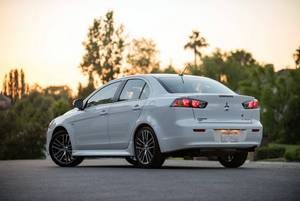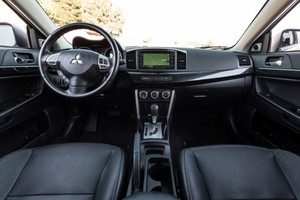Timeless Or Past Its Time?
Of the dozen or so compact sedans available, the Mitsubishi Lancer is by far the oldest for sale in the U.S. It was launched in 2007 and is now celebrating a remarkable 11th year. On the one hand, it could be considered obsolete. On the other, it must be so good or it wouldn’t still be here without being redesigned. The 2017 Lancer is about value, exterior styling and is also just one of the two sedans in its segment to offer all-wheel drive, with the Subaru Impreza being the other. The Lancer also boasts a 10-year/100,000-mile powertrain warranty.
The base front-wheel-drive Lancer ES model is powered by a 2.0-liter four-cylinder engine that makes 148 horsepower and 145 pounds-feet of torque, which is in line with other compact offerings in the same price range. It can be paired with a standard six-speed manual or optional continuously variable automatic transmission (CVT). The other three Lancer models use a 168 horsepower 2.4-liter four that churns out 168 pounds-feet. It’s mated to a standard CVT and electronically variable all-wheel drive, the same system used in the Outlander Sport crossover SUV.

The 2017 Mitsubishi Lancer is offered in the base ES ($17,795 with manual, $18,795 with CVT), ES AWC ($20,295), SE ($21,095), and SEL ($22,095), with the latter three having standard all-wheel drive.
Fuel economy for the manual transmission Lancer is estimated by the EPA at 24-mpg city/33 highway/28 combined. The optional CVT results in 27-mpg city/34 hwy./30 combined. All-wheel drive models are rated at 23-mpg city/30 hwy./26 combined. All of the fuel economy numbers lag behind most competitors.
Timeless Styling
The 2017 Lancer may have been designed in another time period, but it continues to command attention in today’s market. Despite its age, the Lancer still looks sharp with its nose-down, tail-up sporty stance. Last year Mitsubishi gave the sedan a new front end that backed off some from the boy-racer look. It now has a small grille above the bumper and a larger opening below, making the nose more understated and mature. LED daytime running lights and a chrome trim strip along the window line were added for 2017.
Interior, No So Much
While the exterior still looks fresh, the cabin clearly shows its age. The steering column tilts but does not telescope, and the touchscreen icons along with the physical controls are so small that using them requires diverting too much attention from the road. While there are some soft touch materials, the majority of the cabin looks as if Mitsubishi is still using plastics that are a decade old.

On the bright side, a redesigned center console and an improved audio system display update the dashboard, and new seat fabrics and gloss-black trim on lower-level ES and SE models freshen the interior as well. Now standard is a 6.1-inch touch-screen display that controls audio functions and the optional navigation system. If you like the color black, you’re in luck as that’s the only interior color available.
Front bucket seats are reasonably comfortable, while comfort in the back seat is a definite plus, delivering near-midsize accommodations in a compact package. The small trunk offers a maximum of 12.3 cubic feet of space, but the rear seat folds in a 60/40-split for added cargo flexibility.
The base Lancer 2.0 ES now comes better equipped for 2017 with standard features like a 6.1-inch touch-screen audio display, rearview camera, alloy wheels, Fuse Bluetooth hands-free phone connectivity and a four-speaker audio system with HD Radio and USB input. SE and SEL models have sport-tuned suspension, heated front seats and upgraded audio system, while topline SEL models come with leather interior, rain-sensing windshield wipers and automatic headlights.
Driving Impressions
As I reached for the push button start button, I was surprised to find a black plastic grip that I had to turn like a key to start the car. As the Lancer sparked to life, I was greeted by a large speedometer and tachometer, with a display screen in the middle of the two. The deeply hooded tach and speedometer were crisp and attractive.
The 2.0-liter engine’s performance was adequate for in-town driving, but anemic when merging onto a fast-moving freeway. As I noted in my review of the Toyota Corolla iM, CVTs are not my favorite transmission. Unfortunately for the Lancer, the CVT hasn’t adopted the latest stepped functions that made the similar transmission in the Corolla less objectionable.

That said, the Mitsubishi Lancer has always been on the sportier side compared to more well-known competitors like the Corolla and Nissan Sentra and that remains true. In addition to sporty handling, the Lancer provides a decent ride, adequate braking feel, a somewhat vague steering feel—there are much worse—and good exterior visibility. It traveled down smooth roads just fine, but driving over potholes and broken pavement caused impact shudder to enter the cabin. Plus, interior noise levels reminded me that I was driving a dated compact car.
As for fuel economy, our Lancer matched the EPA’s estimate of 30 mpg after driving 256 miles.
The Compact Sedan for You?
Shoppers who seriously consider the 2017 Mitsubishi Lancer will be those who prioritize value-for-the-money and styling over all other factors. Choosing the 11-year-old sedan over competitors will mean giving up a quieter ride, the latest tech features and better fuel economy. But they’ll be driving a smart-looking compact sedan and have more money in their wallet.
Clean Fleet Report “Flash Drives” are concise reviews of vehicles that include the major points and are easy and quick to read. A “Flash Drive” is often followed later by a comprehensive road test review.
Related Stories You Might Enjoy:
Road Test: 2018 Subaru Impreza
Road Test: 2017 Toyota Corolla
First Drive: 2016 Nissan Sentra
Road Test: 2016 Honda Civic
Road Test: 2017 Chevrolet Cruze
Road Test: 2017 Chevrolet Cruze Hatchback
Road Test: 2017 Mazda3
Disclosure:
Clean Fleet Report is loaned free test vehicles from automakers to evaluate, typically for a week at a time. Our road tests are based on this one-week drive of a new vehicle. Because of this we don’t address issues such as long-term reliability or total cost of ownership. In addition, we are often invited to manufacturer events highlighting new vehicles or technology. As part of these events we may be offered free transportation, lodging or meals. We do our best to present our unvarnished evaluations of vehicles and news irrespective of these inducements.
Our focus is on vehicles that offer the best fuel economy in their class, which leads us to emphasize electric cars, plug-in hybrids, hybrids and diesels. We also feature those efficient gas-powered vehicles that are among the top mpg vehicles in their class. In addition, we aim to offer reviews and news on advanced technology and the alternative fuel vehicle market. We welcome any feedback from vehicle owners and are dedicated to providing a forum for alternative viewpoints. Please let us know your views at publisher@cleanfleetreport.com.
